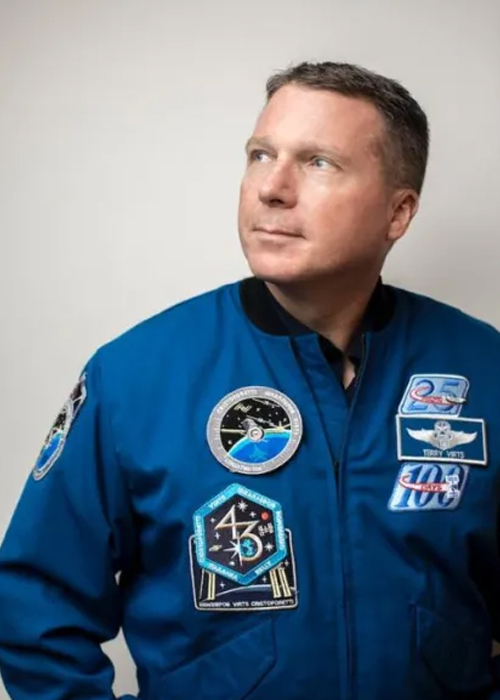We have updated our Privacy Policy Please take a moment to review it. By continuing to use this site, you agree to the terms of our updated Privacy Policy.

Terry Virts
Science, Technology and Innovation; Leadership; Environmentalism; College/University; Business and Management; Library; Politics and National Perspectives
Speaker Bio
Terry Virts is in a very small, prestigious club. He is one of only four astronauts in history to have piloted the space shuttle, flown a Russian Soyuz spacecraft, performed three spacewalks, and commanded the International Space Station (ISS). He also famously took more than 319,000 photographs from space—more than any other astronaut.
Commander Virts’s book How to Astronaut: An Insider’s Guide to Leaving Planet Earth is a firsthand account of his over seven months in space—an experience few will ever know. It captures the highs and lows, with humor and wonder, through stories that range from survival training and space shuttle emergencies to the sublime beauty, unexpected discoveries, and mundane rituals of daily life in space.
Virts peels back the curtain with candid revelations on what it takes to become an astronaut as well as anecdotes from his time as Crew Medical Officer aboard a spaceship (he performed the first-ever dental filling in orbit), working with Russian Space Agency cosmonauts, and performing scientific experiments aboard the ISS. He gives an uncensored and wildly entertaining account of space travel that includes giving a coworker a haircut, caring for small animals, going for a daily run on the treadmill, and emptying the waste system (toilet) on the space shuttle.
Colonel Terry Virts (retired) served in the US Air Force as a fighter pilot, test pilot, and NASA astronaut on two spaceflights. He is a graduate of the US Air Force Academy, Embry-Riddle Aeronautical University, and Harvard Business School, where he earned the 2021 Alumni Achievement Award. He is also the author of the upcoming children’s book The Astronauts Guide as well as View from Above (National Geographic, 2017) and one of the stars (and photographers) of the IMAX film, A Beautiful Planet. He recently directed his first film, One More Orbit.
An internationally in-demand speaker, Virts inspires audiences with stories from space as well as insights into life on earth. Terry brings his unique perspective to businesses around the world on such diverse topics as our environment, intercultural leadership, crisis and risk management, innovation, strategy and vision, and decision-making. He is currently working in the energy industry and is also involved in multiple television, film, and book projects.
FOLLOW TERRY
Speaking Topics
Life in Space
Terry shares stories from his seven months in space to give a front-row seat on a space mission from launch to landing. As the National Geographic Photographer who has taken more photographs from space than any other astronaut, he shares some of his eye-popping imagery to give a feel for what it’s like to look back at the planet, or out into the galaxy, while floating aboard the International Space Station.
The Importance of Innovation
Virts outlines how NASA going to the Moon was the culmination of several programs and missions—they couldn’t have had Apollo without Mercury and Gemini first. He uses this and other examples of a buildup approach and applies these lessons learned to other organizations, giving strategies for how companies must adapt, change, and create a culture of innovation.
Risk and Crisis Management
From rocket companies to investment banks, there are universal techniques to improve safety and risk management. The key is to have a culture that supports this from the top. Virts details how NASA performs risk assessments and how these can be applied in other scenarios and organizations. In addition to assessment tools, he talks about the culture and practices that are ingrained, approaching risk from a rational and statistical framework and not emotional, allocating resources accordingly, and paying attention to institutional history and lessons learned. He uses real life examples from his time at NASA to talk about how to accept and minimize unavoidable risks.
Leadership
Terry Virts shares his experiences from his fighter pilot days and space missions and applies them to the workplace. How ensuring the success of a team requires good followers as well as leaders, and how roles may change from follower to leader and back again. He talks about the importance of vision, goal setting, and the strategy to achieve those goals. He discusses scenarios and which leadership styles are best for each one (from directive to collaborative).
Why Organizations Fail
Based on a course he teaches at Harvard Business School, Virts discusses the Columbia and Challenger disasters and how the same mistakes were made by NASA more than once. He talks about the culture created within organizations—from communication styles and politics as well as ego and personalities and how to prioritize what matters. In the aerospace industry, there is always an indication that something is wrong before a crash, and this holds true for catastrophes in any business sector.
Our Beautiful Planet and Its Fragile Environment
Perspective on our place in the universe and our only planet, Earth. We have a beautiful planet, but there are serious environmental challenges that we need to meet. Virts shares a positive story about how his home on the Chesapeake bay was confronted with serious pollution in the 1970s, and how tough decisions have dramatically helped improve the environment there.
In the News
By the Author
Booking Info
Terry Virts’ speaking engagements are handled by the Hachette Speakers Bureau, a division of Hachette Book Group and an accredited member of the International Association of Speakers Bureaus. Contact us to learn more.


